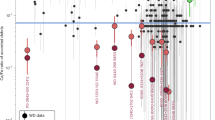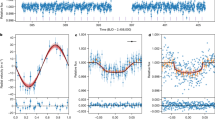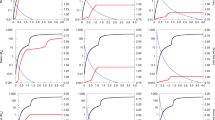Abstract
Recently, gas disks have been discovered around main-sequence stars well beyond the usual protoplanetary disk lifetimes (that is, ≳10 Myr), when planets have already formed1,2,3,4. These gas disks, mainly composed of CO, carbon and oxygen5,6,7, seem to be ubiquitous3 in systems with planetesimal belts (similar to our Kuiper belt), and can last for hundreds of millions of years8. Planets orbiting in these gas disks will accrete9,10 a large quantity of gas that will transform their primordial atmospheres into new secondary atmospheres with compositions similar to that of the parent gas disk. Here we quantify how large a secondary atmosphere can be created for a variety of observed gas disks and for a wide range of planet types. We find that gas accretion in this late phase is very important and an Earth’s atmospheric mass of gas is readily accreted on terrestrial planets in very tenuous gas disks. In slightly more massive disks, we show that massive CO atmospheres can be accreted, forming planets with up to sub-Neptune-like pressures. Our results demonstrate that new secondary atmospheres with high metallicities and high C/O ratios will be created in these late gas disks, resetting their primordial compositions inherited from the protoplanetary disk phase, and providing a new birth to planets that lost their atmosphere to photoevaporation or giant impacts. We therefore propose a new paradigm for the formation of atmospheres on low-mass planets, which can be tested with future observations (James Webb Space Telescope (JWST), Extremely Large Telescope (ELT), Atmospheric Remote-sensing Infrared Exoplanet Large-survey (ARIEL). We also show that this late accretion would show a very clear signature in sub-Neptunes or cold exo-Jupiters. Finally, we find that accretion creates cavities in late gas disks, which could be used as a new planet detection method, for low-mass planets a few to a few tens of astronomical units from their host stars.
This is a preview of subscription content, access via your institution
Access options
Access Nature and 54 other Nature Portfolio journals
Get Nature+, our best-value online-access subscription
$29.99 / 30 days
cancel any time
Subscribe to this journal
Receive 12 digital issues and online access to articles
$119.00 per year
only $9.92 per issue
Buy this article
- Purchase on Springer Link
- Instant access to full article PDF
Prices may be subject to local taxes which are calculated during checkout




Similar content being viewed by others
Data availability
The data that support the plots within this paper and other findings of this study are available from the corresponding author upon reasonable request.
Code availability
The particular scripts used for the analysis are made in python and available on reasonable request from the corresponding author.
Change history
18 August 2020
A Correction to this paper has been published: https://doi.org/10.1038/s41550-020-1205-1
References
Dent, W. R. F. et al. Molecular gas clumps from the destruction of icy bodies in the β Pictoris debris disk. Science 343, 1490–1492 (2014).
Lieman-Sifry, J. et al. Debris disks in the scorpius-centaurus OB association resolved by ALMA. Astrophys. J. 828, 25 (2016).
Moór, A. et al. Molecular gas in debris disks around young A-type stars. Astrophys. J. 849, 123 (2017).
Matrà, L., Öberg, K. I., Wilner, D. J., Olofsson, J. & Bayo, A. On the ubiquity and stellar luminosity dependence of exocometary CO gas: detection around M dwarf TWA 7. Astron. J. 157, 117 (2019).
Cataldi, G. et al. Herschel/HIFI observations of ionised carbon in the β Pictoris debris disk. Astron. Astrophys. 563, A66 (2014).
Kral, Q., Matrà, L., Wyatt, M. C. & Kennedy, G. M. Predictions for the secondary CO, C and O gas content of debris discs from the destruction of volatile-rich planetesimals. Mon. Not. R. Astron. Soc. 469, 521–550 (2017).
Higuchi, A. E. et al. Detection of submillimeter-wave [C i] emission in gaseous debris disks of 49 Ceti and β Pictoris. Astrophys. J. 839, L14 (2017).
Matrà, L. et al. Detection of exocometary CO within the 440 Myr old Fomalhaut belt: a similar CO+CO2 ice abundance in exocomets and Solar System comets. Astrophys. J. 842, 9 (2017).
Lee, E. J., Chiang, E. & Ormel, C. W. Make super-Earths, not Jupiters: accreting nebular gas onto solid cores at 0.1 au and beyond. Astrophys. J. 797, 95 (2014).
Lee, E. J. & Chiang, E. To cool is to accrete: analytic scalings for nebular accretion of planetary atmospheres. Astrophys. J. 811, 41 (2015).
Kóspál, Á. et al. ALMA observations of the molecular gas in the debris disk of the 30 Myr old star HD 21997. Astrophys. J. 776, 77 (2013).
Zuckerman, B. & Song, I. A 40 Myr old gaseous circumstellar disk at 49 Ceti: massive CO-rich comet clouds at young A-type stars. Astrophys. J. 758, 77 (2012).
Kral, Q. & Latter, H. The magnetorotational instability in debris-disc gas. Mon. Not. R. Astron. Soc. 461, 1614–1620 (2016).
Kral, Q. et al. A self-consistent model for the evolution of the gas produced in the debris disc of β Pictoris. Mon. Not. R. Astron. Soc. 461, 845–858 (2016).
Kral, Q. et al. Around HD 131835: reinterpreting young debris discs with protoplanetary disc levels of CO gas as shielded secondary discs. Mon. Not. R. Astron. Soc. 489, 3670–3691 (2019).
Testi, L. et al. Hunting for planets in the HL tau disk. Astrophys. J. 812, L38 (2015).
Thureau, N. D. et al. An unbiased study of debris discs around A-type stars with Herschel. Mon. Not. R. Astron. Soc. 445, 2558–2573 (2014).
Keppler, M. et al. Discovery of a planetary-mass companion within the gap of the transition disk around PDS 70. Astron. Astrophys. 617, A44 (2018).
Müller, A. et al. Orbital and atmospheric characterization of the planet within the gap of the PDS 70 transition disk. Astron. Astrophys. 617, L2 (2018).
Haffert, S. Y. et al. Two accreting protoplanets around the young star PDS 70. Nat. Astron. 3, 749–754 (2019).
Nimmo, F. & Kleine, T. How rapidly did mars accrete? Uncertainties in the Hf–W timing of core formation. Icarus 191, 497–504 (2007).
Jacobsen, S. B. The Hf–W isotopic system and the origin of the Earth and Moon. Annu. Rev. Earth Planet. Sci. 33, 531–570 (2005).
Owen, J. E. Atmospheric escape and the evolution of close-in exoplanets. Annu. Rev. Earth Planet. Sci. 47, 67–90 (2019).
Yalinewich, A. & Schlichting, H. Atmospheric mass-loss from high-velocity giant impacts. Mon. Not. R. Astron. Soc. 486, 2780–2789 (2019).
Quintana, E. V., Barclay, T., Borucki, W. J., Rowe, J. F. & Chambers, J. E. The frequency of giant impacts on Earth-like worlds. Astrophys. J. 821, 126 (2016).
Lopez, E. D. & Fortney, J. J. Understanding the mass–radius relation for sub-Neptunes: radius as a proxy for composition. Astrophys. J. 792, 1 (2014).
Lee, E. J. & Chiang, E. Breeding super-Earths and birthing super-puffs in transitional disks. Astrophys. J. 817, 90 (2016).
Grimm, S. L. et al. The nature of the TRAPPIST-1 exoplanets. Astron. Astrophys. 613, A68 (2018).
Kreidberg, L. et al. Clouds in the atmosphere of the super-Earth exoplanet GJ1214b. Nature 505, 69–72 (2014).
Charnay, B., Meadows, V., Misra, A., Leconte, J. & Arney, G. 3D modeling of GJ1214b’s atmosphere: formation of inhomogeneous high clouds and observational implications. Astrophys. J. 813, L1 (2015).
Morley, C. V. et al. Thermal emission and reflected light spectra of super Earths with flat transmission spectra. Astrophys. J. 815, 110 (2015).
Morley, C. V., Kreidberg, L., Rustamkulov, Z., Robinson, T. & Fortney, J. J. Observing the atmospheres of known temperate Earth-sized planets with JWST. Astrophys. J. 850, 121 (2017).
Benneke, B. et al. A sub-Neptune exoplanet with a low-metallicity methane-depleted atmosphere and Mie-scattering clouds. Nat. Astron. 3, 813–821 (2019).
Fraine, J. et al. Water vapour absorption in the clear atmosphere of a neptune-sized exoplanet. Nature 513, 526–529 (2014).
Wakeford, H. R. et al. HAT-P-26b: a neptune-mass exoplanet with a well-constrained heavy element abundance. Science 356, 628–631 (2017).
Benneke, B. et al. Water vapor and clouds on the habitable-zone sub-Neptune exoplanet K2-18b. Astrophys. J. 887, L14 (2019).
Tsiaras, A., Waldmann, I. P., Tinetti, G., Tennyson, J. & Yurchenko, S. N. Water vapour in the atmosphere of the habitable-zone eight-Earth-mass planet K2-18 b. Nat. Astron. 3, 1086–1091 (2019).
Konopacky, Q. M., Barman, T. S., Macintosh, B. A. & Marois, C. Detection of carbon monoxide and water absorption lines in an exoplanet atmosphere. Science 339, 1398–1401 (2013).
GRAVITY Collaboration et al. Peering into the formation history of β Pictoris b with VLTI/GRAVITY long baseline interferometry. Astron. Astrophys. 633, A110 (2020).
Charnay, B. et al. A self-consistent cloud model for brown dwarfs and young giant exoplanets: comparison with photometric and spectroscopic observations. Astrophys. J. 854, 172 (2018).
Janson, M. et al. Direct imaging detection of methane in the atmosphere of GJ 504 b. Astrophys. J. 778, L4 (2013).
Macintosh, B. et al. Discovery and spectroscopy of the young jovian planet 51 Eri b with the gEmini Planet Imager. Science 350, 64–67 (2015).
Skemer, A. J. et al. The LEECH exoplanet imaging survey: characterization of the coldest directly imaged exoplanet, GJ 504 b, and evidence for superstellar metallicity. Astrophys. J. 817, 166 (2016).
Cataldi, G. et al. ALMA resolves C i emission from the β Pictoris debris disk. Astrophys. J. 861, 72 (2018).
Xie, J.-W., Brandeker, A. & Wu, Y. On the unusual gas composition in the β Pictoris debris disk. Astrophys. J. 762, 114 (2013).
Lynden-Bell, D. & Pringle, J. E. The evolution of viscous discs and the origin of the nebular variables. Mon. Not. R. Astron. Soc. 168, 603–637 (1974).
Shakura, N. I. & Sunyaev, R. A. Reprint of 1973A&A….24. 337S. Black holes in binary systems. Observational appearance. Astron. Astrophys. 500, 33 (1973).
Moór, A. et al. New millimeter CO observations of the gas-rich debris disks 49 Cet and HD 32297. Astrophys. J. 884, 108 (2019).
Marino, S. et al. Population synthesis of exocometary gas around A stars. Mon. Not. R. Astron. Soc. (in the press).
Thébault, P. & Augereau, J.-C. Collisional processes and size distribution in spatially extended debris discs. Astron. Astrophys. 472, 169 (2007).
Kral, Q., Thébault, P. & Charnoz, S. LIDT-DD: a new self-consistent debris disc model that includes radiation pressure and couples dynamical and collisional evolution. Astron. Astrophys. 558, A121 (2013).
Wyatt, M. C. Evolution of debris disks. Annu. Rev. Astron. Astrophys. 46, 339–383 (2008).
Dominik, C. & Decin, G. Age dependence of the Vega phenomenon: theory. Astrophys. J. 598, 626 (2003).
Wyatt, M. C. et al. Steady state evolution of debris disks around a stars. Astrophys. J. 663, 365 (2007).
Matrà, L. et al. An empirical planetesimal belt radius–stellar luminosity relation. Astrophys. J. 859, 72 (2018).
Williams, J. P. & Cieza, L. A. Protoplanetary disks and their evolution. Annu. Rev. Astron. Astrophys. 49, 67–117 (2011).
Lee, E. J., Chiang, E. & Ferguson, J. W. Optically thin core accretion: how planets get their gas in nearly gas-free discs. Mon. Not. R. Astron. Soc. 476, 2199 (2018).
Freedman, R. S. et al. Gaseous mean opacities for giant planet and ultracool dwarf atmospheres over a range of metallicities and temperatures. Astrophys. J. Suppl. Ser. 214, 25 (2014).
Tanigawa, T., Ohtsuki, K. & Machida, M. N. Distribution of accreting gas and angular momentum onto circumplanetary disks. Astrophys. J. 747, 47 (2012).
Dorn, C., Mosegaard, K., Grimm, S. L. & Alibert, Y. Interior characterization in multiplanetary systems: TRAPPIST-1. Astrophys. J. 865, 20 (2018).
Robinson, T. D. & Catling, D. C. Common 0.1 bar tropopause in thick atmospheres set by pressure-dependent infrared transparency. Nat. Geosci. 7, 12–15 (2014).
Ormel, C. W., Shi, J.-M. & Kuiper, R. Hydrodynamics of embedded planets’ first atmospheres—II. A rapid recycling of atmospheric gas. Mon. Not. R. Astron. Soc. 447, 3512–3525 (2015).
Béthune, W. & Rafikov, R. R. Envelopes of embedded super-Earths—II. Three-dimensional isothermal simulations. Mon. Not. R. Astron. Soc. 488, 2365–2379 (2019).
Fung, J., Artymowicz, P. & Wu, Y. The 3D flow field around an embedded planet. Astrophys. J. 811, 101 (2015).
D’Angelo, G. & Bodenheimer, P. Three-dimensional radiation-hydrodynamics calculations of the envelopes of young planets embedded in protoplanetary disks. Astrophys. J. 778, 77 (2013).
Dullemond, C. P. et al. RADMC-3D: a multi-purpose radiative transfer tool. Astrophysics Source Code Library ascl:1202.015 (2012).
Acknowledgements
We thank G. Rosotti, P. Thebault and A. Shannon for discussions. Q.K. deidcates this paper to Michaël.
Author information
Authors and Affiliations
Contributions
Q.K. led the work, proposed the original idea, wrote the manuscript and produced Figs. 3 and 4. J.D. coded the model and produced Figs. 1 and 2. B.C. provided atmospheric parameters to input into the model, expertise in atmosphere observations and produced the synthetic spectra shown in the paper. All authors contributed to the interpretation of the results and commented on the paper.
Corresponding author
Ethics declarations
Competing interests
The authors declare no competing interests.
Additional information
Publisher’s note Springer Nature remains neutral with regard to jurisdictional claims in published maps and institutional affiliations.
Extended data
Extended Data Fig. 1 Typical viscous evolution timescales.
We plot the viscous timescale tν as a function of the viscous parameter α for different belt locations (50, 100 and 150 au) and different gas temperatures (10, 30 and 100 K).
Extended Data Fig. 2 Evolution of \(\dot{M}\) with time.
We plot the temporal evolution of \(\dot{M}\) for different belt locations (50 and 100 au) and different initial belt masses (0.1, 1, 10, and 100 M⊕).
Extended Data Fig. 3 GCR for different values of mean molecular weight μ.
Temporal evolution of the gas-to-core ratio (GCR) with varying μ. We note that the GCR grows more slowly than expected for the cases μ = 7 and 14 when \(\dot{M}=1{0}^{-2}\) M⊕/Myr, which is because the theoretical cooling accretion rate becomes smaller than 10−2 M⊕/Myr for lower values of μ (see Extended Data Fig. 4). We also see that for lower values of μ, the accretion is less efficient from the start because the gas disk scaleheight is higher and less gas is accreted (see Extended Data Fig. 5).
Extended Data Fig. 4 Potential accretion rate on a planet Vs. available accretion rates.
We plot the temporal evolution of the potential theoretical accretion rate on a planet \({\dot{M}}_{{\rm{gas}}}\) (numerical derivative with κ varying with time) for different values of planet semi-major axes apl, atmospheric mean molecular weight μ and core mass \({M}_{{\rm{core}}}\). The fiducial model is apl = 1 au, μ = 14, and \({M}_{{\rm{core}}}=1\) M⊕. We overplot horizontal lines with different input rate values of our parameter \(\dot{M}\), including the case of 10−2 M⊕/Myr over 100 Myr to verify whether in the cases studied in this paper the theoretical accretion rate is higher than our \(\dot{M}\) parameter (which is always the case for μ = 28, large \({M}_{{\rm{core}}}\) or distant planets). We note that for the μ = 28 case, the green lines become less steep at large t. This is because as t increases, one reaches the second regime for which − a∕(bt) ≪ 1, where \({\dot{M}}_{{\rm{gas}}}\) scales as t−0.4 instead of t−0.7 in the other regime (see Eqs 9 and 10). We also note that for the case at 0.1 au (for which T = 1000 K), the opacity varies more slowly with T for high enough densities and β becomes smaller10, hence leading to a higher \({\dot{M}}_{{\rm{gas}}}\).
Extended Data Fig. 5 Is a planet accreting all gas flowing through the disk?
We plot the Hill sphere radius-to-scaleheight ratio Vs. the distance to host star. For the lowest-mass planets, the Hill sphere radius can be smaller than the disk scaleheight and gas can flow inwards rather than being accreted.
Extended Data Fig. 6 GCR and pressures for a Mars-mass and a distant planet.
Temporal evolution of the gas-to-core ratio (left) and pressure (right) for a Mars-mass (0.1 M⊕ at 1.5 au) planet and a distant planet (10 au) with a core mass of 0.5 M⊕ up to a GCR of 0.5. In the pressure plot (right), the thick solid line is for the Mars-like planet case and the thinner line is for the core of mass 0.5 M⊕ at 10 au. We note that for the Mars-mass case, GCR grows more slowly than expected when \(\dot{M}=1{0}^{-2}\) M⊕/Myr, which is because the theoretical cooling accretion rate becomes smaller than 10−2 M⊕/Myr in this case (see Extended Data Fig. 4).
Extended Data Fig. 7 Hill Vs. Bondi radii.
Hill and Bondi radii Vs. planet mass for different planet semi-major axes.
Extended Data Fig. 8 GCR and pressures for a planet starting with an Earth atmospheric mass.
Temporal evolution of the gas-to-core ratio (left) and pressure (right) starting from a pre-existing atmosphere with an Earth atmospheric mass.
Supplementary information
Supplementary Information
Supplementary Figs. 1–4 and discussion.
Rights and permissions
About this article
Cite this article
Kral, Q., Davoult, J. & Charnay, B. Formation of secondary atmospheres on terrestrial planets by late disk accretion. Nat Astron 4, 769–775 (2020). https://doi.org/10.1038/s41550-020-1050-2
Received:
Accepted:
Published:
Issue Date:
DOI: https://doi.org/10.1038/s41550-020-1050-2
This article is cited by
-
Magma Ocean, Water, and the Early Atmosphere of Venus
Space Science Reviews (2023)
-
Renovation by late nebular accretion
Nature Astronomy (2020)



